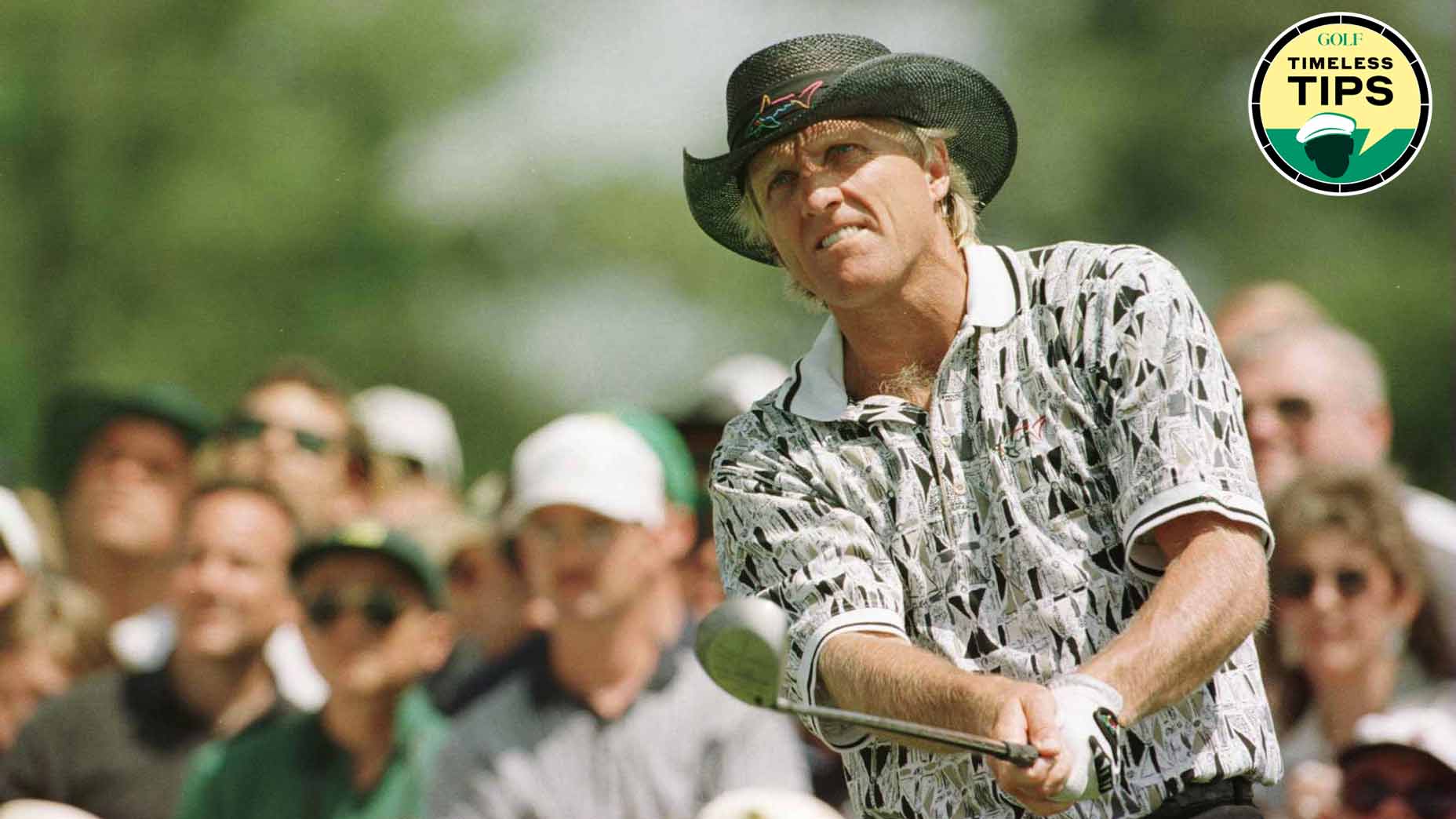
Greg Norman was a heck of a ball striker during his playing career.
Getty Images
Golf instruction is ever-evolving, but the best advice stands the test of time. In GOLF.com’s new series, Timeless Tips, we’re highlighting some of the greatest advice teachers and players have dispensed in the pages of GOLF Magazine. Today, we look back at our October 1995 issue where Greg Norman shared three tips for driving the ball long and straight. For unlimited access to the full GOLF Magazine digital archive, join InsideGOLF today; you’ll enjoy $140 of value for only $39.99/year.
With Greg Norman being such a polarizing figure in the modern golf landscape it can be easy to forget that he was a heck of a player during his career. With 20 PGA Tour titles and two major championships, he was among the game’s best players during his playing prime.
Much of that success can be attributed to his incredible ball-striking skills — particularly off the tee. With a driver in his hands, Norman was long and straight, a lethal combo that allowed him to pick apart courses like few others could.
If you are curious about what drove Norman’s success, you’re in luck. Back in 1995, the Shark penned a feature for GOLF Magazine outlining three tips for hitting the ball long and straight, which we’ve reproduced below. Check it out.
Norman’s 3 driving tips
As a youngster I loved sports, playing everything from rugby to cricket. But it wasn’t until I was 15 that I borrowed my Mum’s clubs and had my first go at golf at the Virginia Golf Club near our home in Queensland, Australia.
I hit many more bad shots than good that day and I don’t remember my score. But I do remember that my few solid drives hooked me on the game. Immediately after the round, I picked up a copy of Jack Nicklaus’ Golf My Way and began my education.
Three years later, with my handicap down to scratch, I won my first tournament, the Queensland Junior Championship. Three years after that, at age 21, I won my first Australian pro event — the 1976 West Lakes Classic.
In 1983, having won in numerous countries, I decided to join the PGA Tour and meet the challenge of America head on. After just eight years, I had eight titles and earnings of more than $4,250,000. My banner year was 1990, when I won Doral and The Memorial, and captured the Arnold Palmer award for leading money-winner. I felt on top of the world.
A year later, my game hit rock bottom! I finished 53rd on the money list. More importantly, I’d fallen way down in some key statistical categories, notably driving accuracy and greens in regulation.
When I looked back at that year, it didn’t take long to realize I needed help. For 20 years I’d been relying on good genes, Jack’s book, and some tips from Australian teacher Charlie Erp, who, in the early years, had smoothed out some of the rough edges in my game. But it was time to move forward, to build a swing less dependent on perfect timing and rigorous practice, and more likely to stand up under pressure.
I needed a new teacher, someone I could trust. After a long search I chose Claude “Butch” Harmon.
Butch was honest. His first words after watching me hit a bag of balls at the TPC The Woodlands in Houston, Texas, were, “Greg, your stance is too narrow; your footwork is poor; the swing is too long and too steep; and your hips sway on the backswing then slide on the downswing.”
At that moment, I knew what Nick Faldo and Nick Price must have felt years earlier when they made the commitment to revamp their swings. I knew that if I wanted to play world-class golf, not only would I have to sacrifice some playing time for practice, but in many ways I would have to start from scratch.
I practiced diligently in 1992, and it was worth it: I climbed back to 18th in money on Tour and my stats improved. In 1993, I finished third in money and won the British Open at Royal St. George’s. Last year, I was second on the money list and proved a lot to the golf world — and myself — by winning The Players Championship with a 24-under-par 264 over the TPC at Sawgrass.
This year, quite simply, I’m playing the best golf of my life.
I still work with Butch, going in for a swing check whenever and wherever I can. We return to the same keys, the ones that now let me swing more powerfully and hit a controlled draw rather than my old fade (and sometimes block). The keys are a slightly strong grip; wide stance; and fluid hip turn.
You don’t have to be a Tour player or even a low-handicapper to find success with my keys. You don’t have to follow every instruction tip to the letter to develop a better understanding of your swing and where it can be improved. But you do have to go back to the fundamentals, as I did, study them, and adapt them to your needs.
I think these keys can help you. I know they really helped me.
1. Semi-strong, “Intermesh” grip
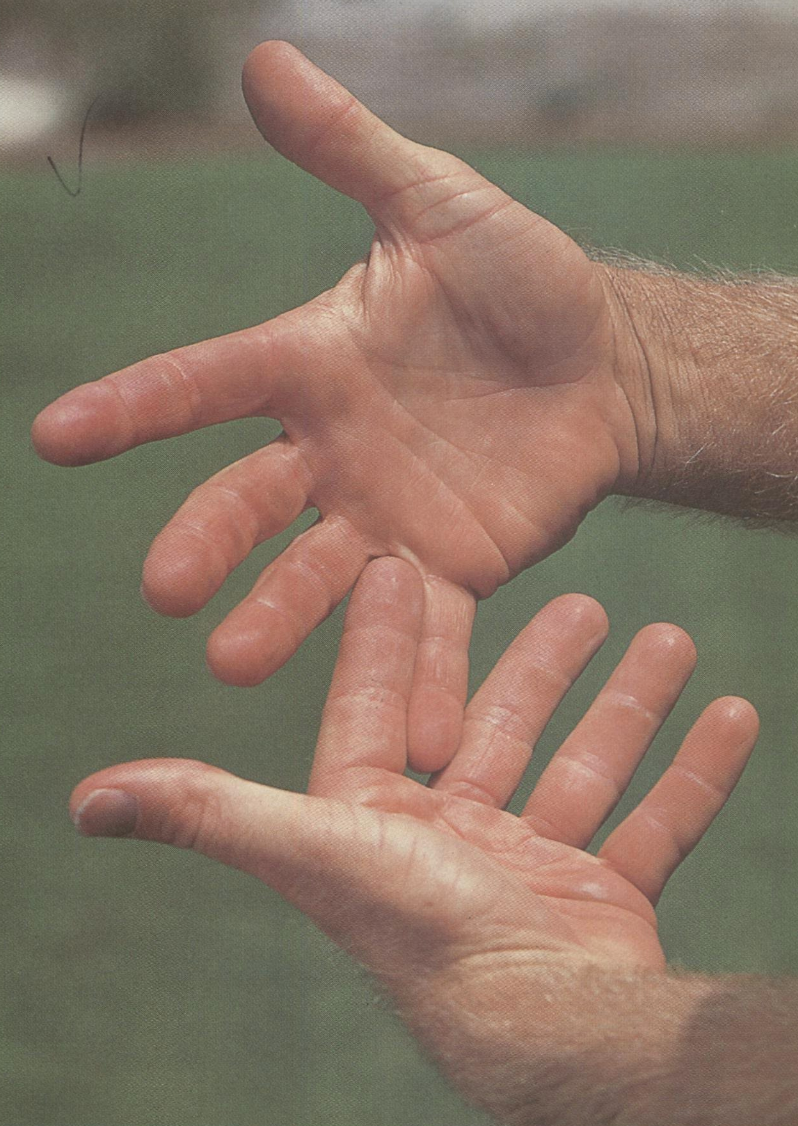
Your hands are the only part of your body touching the club, so they must be comfortable and work together when forming a grip.
When I first started playing golf, none of the grip options — overlap, interlock, or 10-finger — felt comfortable or secure. I felt as if my hands were fighting each other when I wanted them functioning as a team. I experimented and invented a grip that wedded my hands comfortably to the club.
Call it the “intermesh” because its key feature is the position of the right pinkie—meshed snugly between the index and middle fingers of the left hand. My hands are not very large, and this hold works best for me.
Also unusual about my grip is club placement. Traditional teaching calls for holding the club in the palm and fingers of the left hand and in the fingers of the right hand. I don’t follow those rules, nor do I assume a neutral grip.
Since this year’s Masters I hold the club almost entirely in the fingers of my left hand: This lets me rotate that hand a notch more to the right (away from the target), into a slightly stronger position. My left thumb presses lightly on the right side of the grip.
Butch showed me how a semistrong left hand sets the left forearm slightly to the right at address, encouraging it to rotate on the backswing and place the club on the correct inside path. Coming down, the stronger grip enhances the releasing action of your arms, hands, and the club, closing the clubface through impact and promoting a draw.
In the right hand, resting the club along the base of the fingers increases my sense of security and confidence. Gripping up in the fingers can weaken control of the club at the top or through impact, when the club is moving as fast as 120 miles per hour.
I have two further checkpoints for the grip: 1) My left thumb fits into the crease under the pad of my right hand. 2) Rather than squeezing more tightly with the right hand, I maintain the same degree of pressure in both hands — about 7 on a 1-to-10 scale.
Even if you’re not comfortable with the intermesh, try a stronger left hand. And however you grip the club, be sure your hands form a single unit and work together, which you ensure by setting the palms parallel.
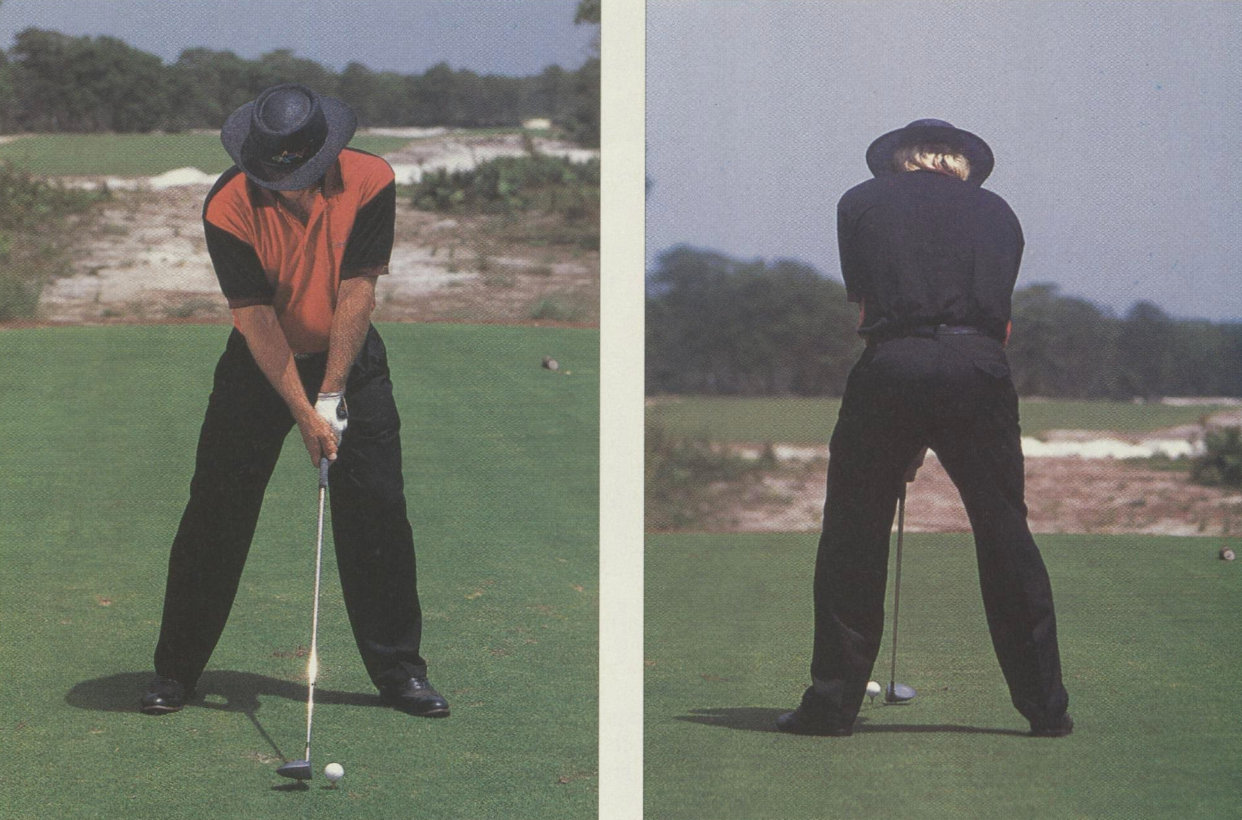
Just as the hands are the only link to the club, your feet are the only connection to the ground. Therefore, -you must start with a solid foundation. On the tee, this means setting up with your feet spread shoulder-width apart, measuring — and this is important — at the inside of the heels.
I knew that Ben Hogan played from an extra-wide stance, but I was always so busy thinking about positions and swing angles that I never thought to look down at my feet. Butch educated me on the value of a wide stance.
A wide stance leads to several improvements:
—A longer takeaway and wider swing arc.
—A shorter, more compact swing.
—A turn, rather than slide, of your hips.
At 6-foot-1, it felt natural to take a narrow stance. And I’d played pretty well that way. What I didn’t know was that compensatory moves and brute strength were allowing me to get away with it. But not all the time.
Every now and again, and often when it counted most, the narrow stance would fail me. I’d swing on such a narrow arc that my right wrist would hinge too much at the top, causing the club to drop well below parallel. I’d be at what Butch calls “the point of no return,” unable to bail out and save the swing. So I’d cast the club, slide into impact with my hips too high, reach impact with the clubface open, and block the shot to the right of target.
No more. On every swing I check my stance. I see many amateurs who could improve by setting their feet farther apart. It isn’t easy to do at first. I suggest you picture a baseball shortstop in the ready position. Where are his feet? Spread shoulder-width apart so his entire body is ready for action.
3. Shift and rotate the hips
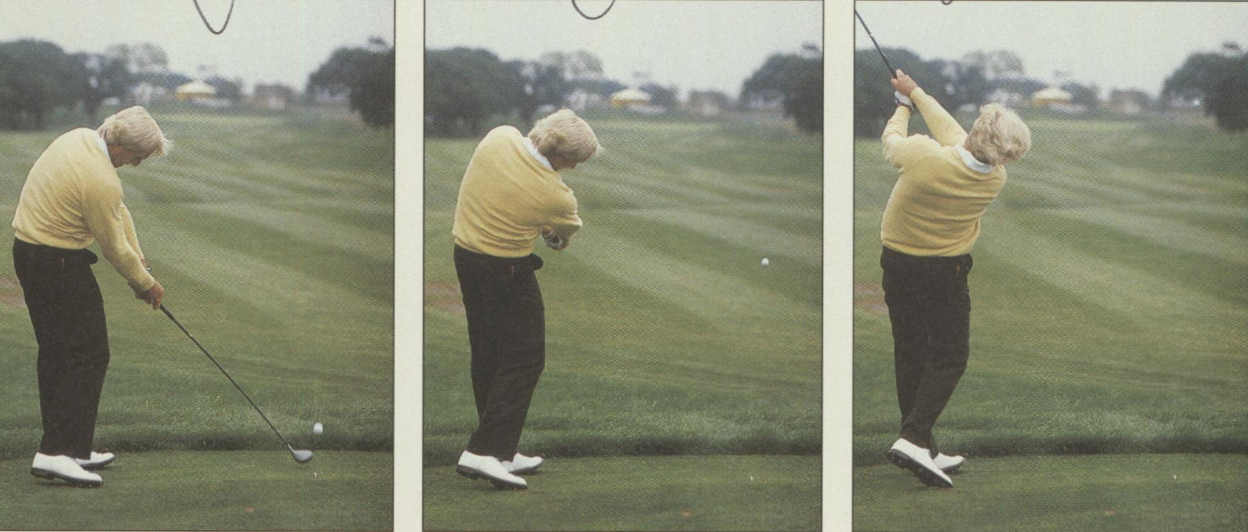
I never thought there was a problem with my foot-action until I saw my swing on videotape, sliding my right foot backward through impact. As Butch explained, that was another reason I tended to fall back and block shots to the right, particularly under pressure.
A wider stance helped control many parts of my game: I stopped coming out of my knee flex, and stopped swaying my hips back and through. As a result, my footwork improved, but not enough.
I needed to keep my left foot fully on the ground and my right foot from sliding. To do that I had to stop thinking about driving the legs on the downswing and start rotating my hips. Butch said the results would be better balance, a consistently square impact position, and keeping the clubface on the ball a split-second longer for long, accurate shots.
Hip rotation was also the only way to stop finishing in a severe ReverseC position, which was taking a toll on my back and hips.
Butch worried that if I consciously thought about rotation, I would start spinning the hips too violently, causing more problems. He consulted with my physical trainer, Pete Draovitch, who taught me a simple drill to ingrain proper hip action and increase my flexibility: Stand in the address position holding a medicine ball. From the set-up, turn away from a target, then turn back, releasing the ball toward the target.
The drill works. Even if you substitute a basketball for a medicine ball, you quickly learn proper hip rotation and the feeling of releasing the right arm over the left through impact, necessary for hitting a draw.
More flexibility and good hip rotation let me swing through aggressively and safely— there’s no more foot-slide or severe Reverse-C. I make more solid contact and draw the ball, giving Mme. extra. distance through added roll. You can see the differences in my downswing and shot shape by comparing my new swing sequence photographs to the old ones. Look how far right the ball starts in the old swing; you can see it drawing (and the clubhead closing) in the new.
Work on hip rotation, rather than sliding, and see if a number of your lower-body mistakes don’t disappear.
Latest In Instruction
https://ift.tt/hVCr5Ly
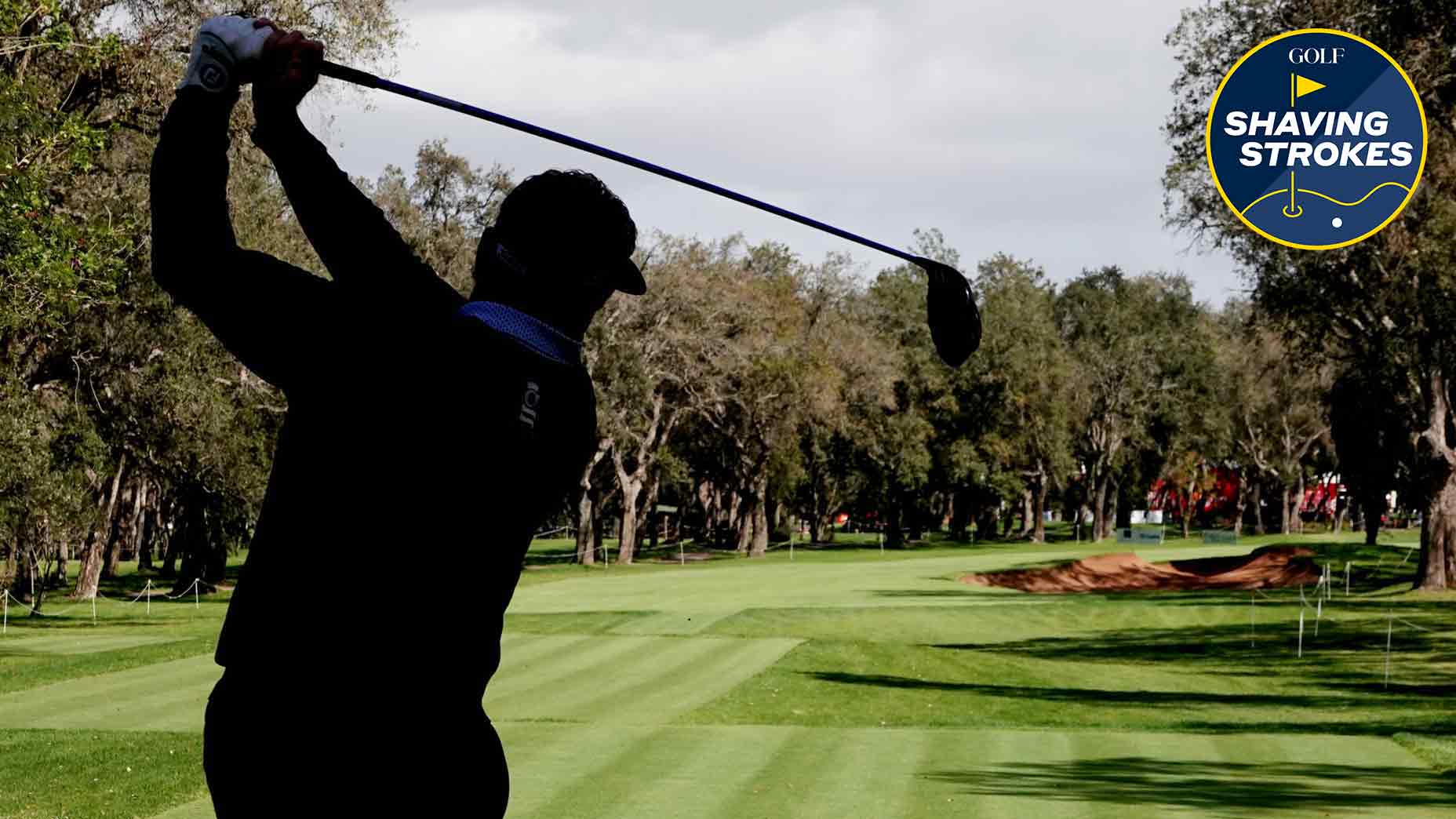

Tidak ada komentar:
Posting Komentar